从物称与人称角度探讨英汉翻译策略
- 格式:doc
- 大小:111.00 KB
- 文档页数:19
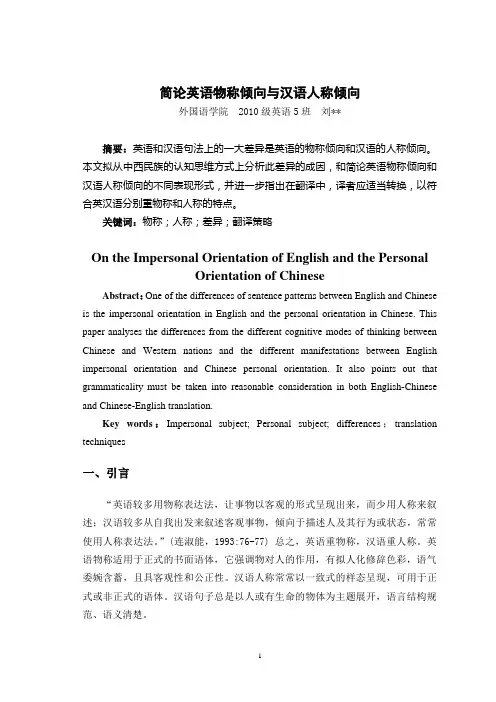
简论英语物称倾向与汉语人称倾向外国语学院 2010级英语5班刘**摘要:英语和汉语句法上的一大差异是英语的物称倾向和汉语的人称倾向。
本文拟从中西民族的认知思维方式上分析此差异的成因,和简论英语物称倾向和汉语人称倾向的不同表现形式,并进一步指出在翻译中,译者应适当转换,以符合英汉语分别重物称和人称的特点。
关键词:物称;人称;差异;翻译策略On the Impersonal Orientation of English and the PersonalOrientation of ChineseAbstract:One of the differences of sentence patterns between English and Chinese is the impersonal orientation in English and the personal orientation in Chinese. This paper analyses the differences from the different cognitive modes of thinking between Chinese and Western nations and the different manifestations between English impersonal orientation and Chinese personal orientation. It also points out that grammaticality must be taken into reasonable consideration in both English-Chinese and Chinese-English translation.Key words:Impersonal subject; Personal subject; differences;translation techniques一、引言“英语较多用物称表达法,让事物以客观的形式呈现出来,而少用人称来叙述;汉语较多从自我出发来叙述客观事物,倾向于描述人及其行为或状态,常常使用人称表达法。
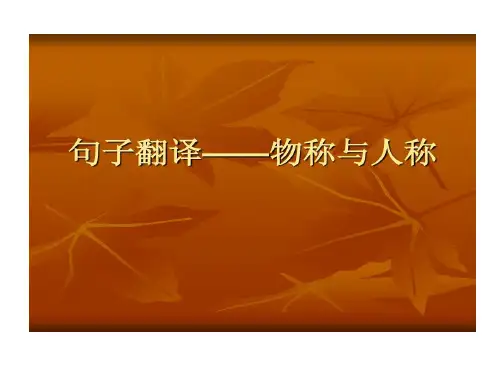

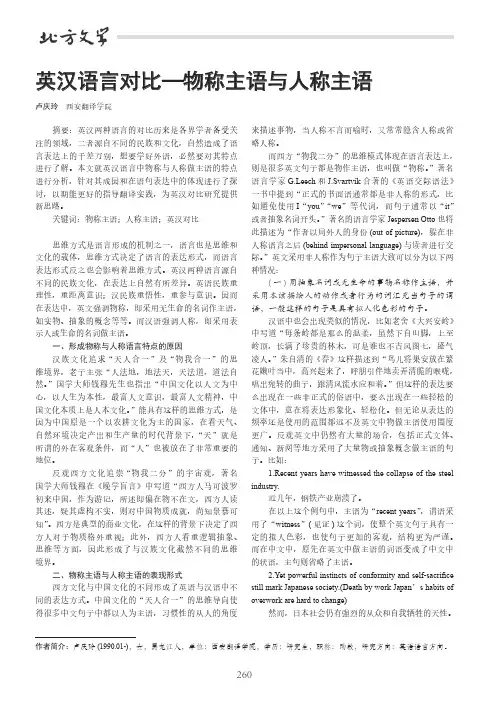
260英汉语言对比—物称主语与人称主语卢庆玲 西安翻译学院摘要:英汉两种语言的对比历来是各界学者备受关注的领域,二者源自不同的民族和文化,自然造成了语言表达上的千差万别,想要学好外语,必然要对其特点进行了解。
本文就英汉语言中物称与人称做主语的特点进行分析,针对其成因和在语句表达中的体现进行了探讨,以期能更好的指导翻译实践,为英汉对比研究提供新思路。
关键词:物称主语;人称主语;英汉对比思维方式是语言形成的机制之一,语言也是思维和文化的载体,思维方式决定了语言的表达形式,而语言表达形式反之也会影响着思维方式。
英汉两种语言源自不同的民族文化,在表达上自然有所差异。
英语民族重理性,重距离意识;汉民族重悟性,重参与意识。
因而在表达中,英文强调物称,即采用无生命的名词作主语,如实物、抽象的概念等等。
而汉语强调人称,即采用表示人或生命的名词做主语。
一、形成物称与人称语言特点的原因汉族文化追求“天人合一”及“物我合一”的思维境界,老子主张“人法地,地法天,天法道,道法自然。
”国学大师钱穆先生也指出“中国文化以人文为中心,以人生为本性,最富人文意识,最富人文精神,中国文化本质上是人本文化。
”能具有这样的思维方式,是因为中国原是一个以农耕文化为主的国家,在看天气、自然环境决定产出和生产量的时代背景下,“天”就是所谓的外在客观条件,而“人”也被放在了非常重要的地位。
反观西方文化追崇“物我二分”的宇宙观,著名国学大师钱穆在《晚学盲言》中写道“西方人马可波罗初来中国,作为游记,所述即偏在物不在文,西方人读其述,疑其虚构不实,则对中国物质成就,尚知景慕可知”。
西方是典型的商业文化,在这样的背景下决定了西方人对于物质格外重视;此外,西方人看重逻辑抽象、思维等方面,因此形成了与汉族文化截然不同的思维境界。
二、物称主语与人称主语的表现形式西方文化与中国文化的不同形成了英语与汉语中不同的表达方式。
中国文化的“天人合一”的思维导向使得很多中文句子中都以人为主语,习惯性的从人的角度来描述事物,当人称不言而喻时,又常常隐含人称或省略人称。

简论英语物称倾向与汉语人称倾向外国语学院 2010级英语5班刘**摘要:英语和汉语句法上的一大差异是英语的物称倾向和汉语的人称倾向。
本文拟从中西民族的认知思维方式上分析此差异的成因,和简论英语物称倾向和汉语人称倾向的不同表现形式,并进一步指出在翻译中,译者应适当转换,以符合英汉语分别重物称和人称的特点。
关键词:物称;人称;差异;翻译策略On the Impersonal Orientation of English and the PersonalOrientation of ChineseAbstract:One of the differences of sentence patterns between English and Chinese is the impersonal orientation in English and the personal orientation in Chinese. This paper analyses the differences from the different cognitive modes of thinking between Chinese and Western nations and the different manifestations between English impersonal orientation and Chinese personal orientation. It also points out that grammaticality must be taken into reasonable consideration in both English-Chinese and Chinese-English translation.Key words:Impersonal subject; Personal subject; differences;translation techniques一、引言“英语较多用物称表达法,让事物以客观的形式呈现出来,而少用人称来叙述;汉语较多从自我出发来叙述客观事物,倾向于描述人及其行为或状态,常常使用人称表达法。
![[重点]论英汉翻译中的视角转换](https://uimg.taocdn.com/8974f67c793e0912a21614791711cc7931b77824.webp)
论英汉翻译中的视角转换1.引言语言是文化的载体,体现人类的思维活动。
不同的文化对语言风格和表达方式产生了极大的影响,使得语言中的视角存在一定的差异,因此在翻译时,译者要挣脱原语文化的传统思维模式,使原语所传达的信息,所体现的风格一并能被读者完全体会。
这就要求译者在了解语言文化背景及视角差异的基础上,在翻译过程中进行视角转换。
2.文献回顾在研究翻译的视角转换这个领域已有不少学者涉及,研究成果也颇丰富。
如刘保华在“英汉翻译技巧:视角转换”中介绍了主要的视角转换法;邵卫平在他的“英汉视角对比及翻译中的视角转换”也对如何进行视角转换进行了相关阐述;张小珊在“中英文翻译视角转换浅议”中提出了自己的观点。
当然还有很多专家学者对这一论题进行了探讨,在这暂不一一列举。
本文准备从英汉翻译视角转换的重要性和视角转换的方法入手,就这个论题谈谈我的观点。
3.英汉翻译中的视角转换翻译在很大程度上不仅是语言的交流,更是文化之间的交流。
由于英、汉语在产生的背景、经历的历史上有很大的不同,许多文化的观察视角也就有了很大区别。
请看如下一例: What we lose in hake we shall have in herring. (失之东隅,收之桑榆。
) 在此例中原句用了hake(鳕鱼)和herring(鲱鱼)两种鱼来表示,因为历史上西方人以航海捕鱼闻名,各种鱼类对他们而言是非常必需的,从中就可以看出西方人的生活习惯。
但如果直译成“我们从鳕鱼中失去的将会从鲱鱼中得到”,中国读者就不明其意了。
如果换成中国人熟悉的“东隅”“桑榆”两个词,就能达到意义上的对等,中国读者便能很清楚地了解这句话所传达的意思。
3.1翻译中视角转换的必要性译者在翻译过程中自始至终都在考虑如何将原语传递到译语中,而在信息传递的过程中,转换是必不可少的。
刘宓庆先生说:“转换是翻译中用得最广泛的变通手段。
在一般情况下,转换是获得灵活对应的不可少的应变对策,而失去形式则常常是转换带来的必然结果。
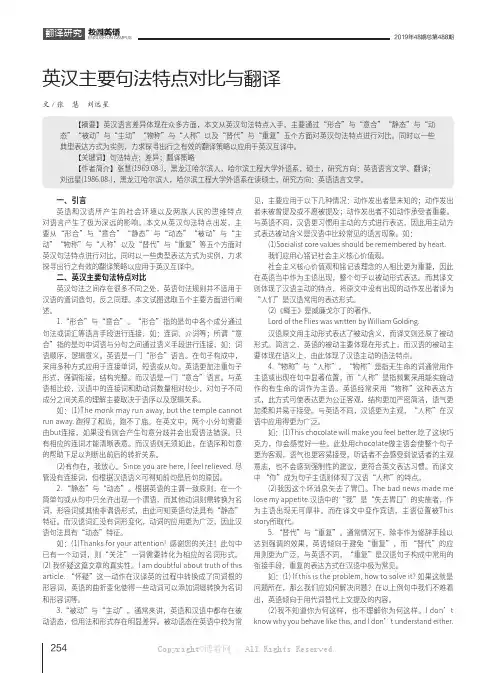
2542019年48期总第488期ENGLISH ON CAMPUS英汉主要句法特点对比与翻译文/张 慧 刘远星见,主要应用于以下几种情况:动作发出者是未知的;动作发出者未被曾提及或不愿被提及;动作发出者不如动作承受者重要。
与英语不同,汉语更习惯用主动的方式进行表达,因此用主动方式表达被动含义是汉语中比较常见的语言现象。
如:(1)Socialist core values should be remembered by heart.我们应用心铭记社会主义核心价值观。
社会主义核心价值观和铭记该理念的人相比更为重要,因此在英语当中作为主语出现,整个句子以被动形式表达。
而其译文则体现了汉语主动的特点,将原文中没有出现的动作发出者译为“人们”是汉语常用的表达形式。
(2)《蝇王》是威廉戈尔丁的著作。
Lord of the Flies was written by William Golding.汉语原文用主动形式表达了被动含义,而译文则还原了被动形式。
简言之,英语的被动主要体现在形式上,而汉语的被动主要体现在语义上,由此体现了汉语主动的语法特点。
4.“物称”与“人称”。
“物称”是指无生命的词通常用作主语或出现在句中显著位置,而“人称”是指频繁采用能实施动作的有生命的词作为主语。
英语经常采用“物称”这种表达方式,此方式可使表达更为公正客观,结构更加严密简洁,语气更加柔和并易于接受。
与英语不同,汉语更为主观,“人称”在汉语中应用得更为广泛。
如:(1)This chocolate will make you feel better.吃了这块巧克力,你会感觉好一些。
此处用chocolate做主语会使整个句子更为客观,语气也更容易接受,听话者不会感受到说话者的主观意志,也不会感到强制性的建议,更符合英文表达习惯。
而译文中 “你”成为句子主语则体现了汉语“人称”的特点。
(2)我因这个坏消息失去了胃口。
The bad news made melose my appetite.汉语中的“我”是“失去胃口”的实施者,作为主语出现无可厚非。
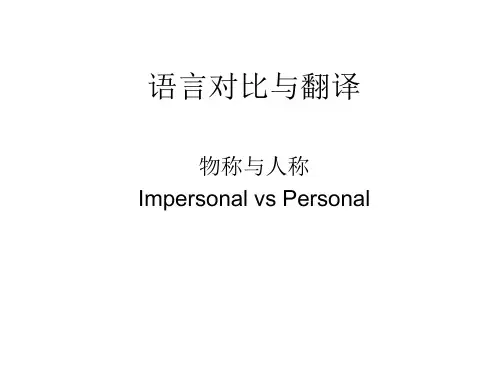
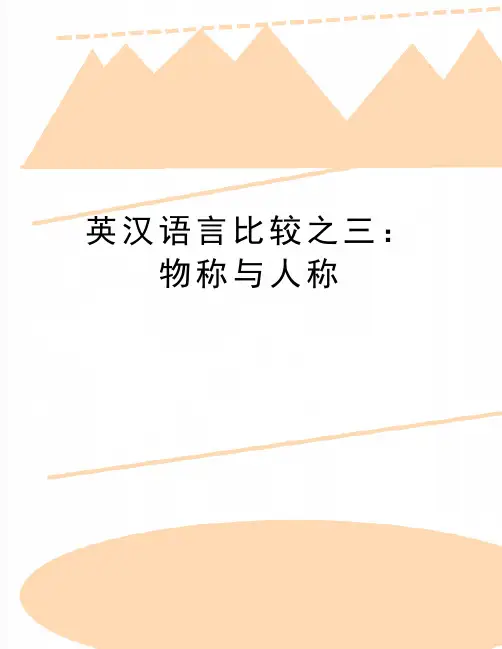
英汉语言比较之三:物称与人称英汉语言比较系列之三综合语(synthetic)的特征是运用形态变化来表达语法关系,拉丁语、德语及古英语等都属于综合语。
分析语(analytic)的特征是不用形态变化而用词序及虚词来表达语法关系,汉语是典型的分析语。
现代英语是从古代英语发展出来的,仍然保留着综合语的某些特征,但是也具有分析语的特点:有形态变化,但不象典型的综合语那么复杂;词序笔汉语灵活,但相对固定;虚词很多,用得也相当频繁。
因此,现代英语属于综合-分析语(synthetic- analytic language)。
从语源(Etymology)观来说,英语属印欧语系(Indo-European Language),汉语则属汉藏语系(Sino-Tibetan language)。
三:物称与人称:英语重物称(impersonal),汉语重人称(personal)英语的物称最显见于其对主语的择定,常选择不能施行动作或无生命事物的词语做主语。
相对而然,汉语一般则更习惯于人称化的表达,尤其是主语,能施行动作或有生命的物体为主语之首选。
究其因,乃是汉语较注重主体思维,这种思维模式以“万物皆备于我”作主导,往往从自我出发来叙述客观事物,或倾向于描述人及行为或状态,因而常用人称。
15)A strange peace came over her when she was alone.她独处时便感到一种特殊的安宁。
16)My good fortune has sent you to me, and we will never part.(H. Andersen: The little Mermaid )我很幸运,能够得到你,让我们永不分离吧。
17)一看到那棵大树,我便想起了童年的情景。
The sight of the big tree always reminds me of my childhood.18)恕我孤陋寡闻,对此关系一无所知。
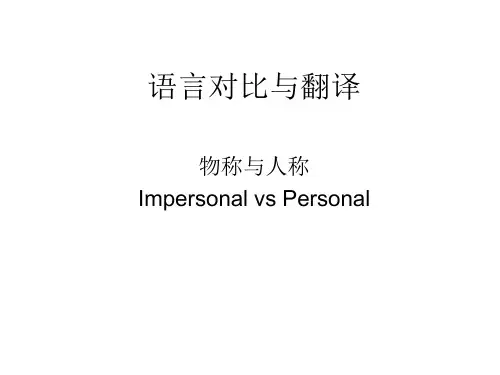
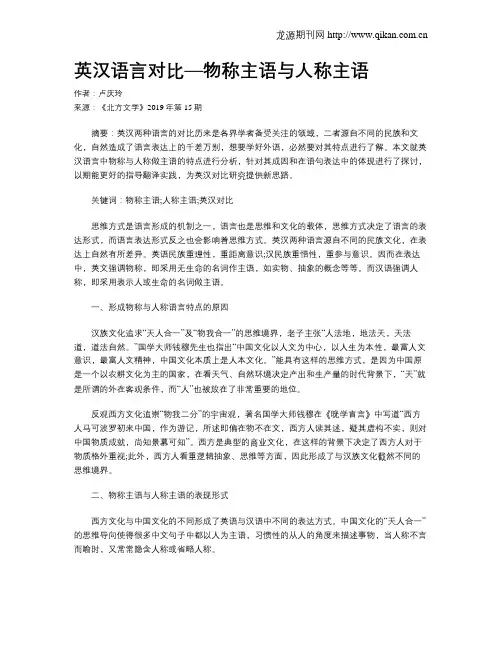
英汉语言对比—物称主语与人称主语作者:卢庆玲来源:《北方文学》2019年第15期摘要:英汉两种语言的对比历来是各界学者备受关注的领域,二者源自不同的民族和文化,自然造成了语言表达上的千差万别,想要学好外语,必然要对其特点进行了解。
本文就英汉语言中物称与人称做主语的特点进行分析,针对其成因和在语句表达中的体现进行了探讨,以期能更好的指导翻译实践,为英汉对比研究提供新思路。
关键词:物称主语;人称主语;英汉对比思维方式是语言形成的机制之一,语言也是思维和文化的载体,思维方式决定了语言的表达形式,而语言表达形式反之也会影响着思维方式。
英汉两种语言源自不同的民族文化,在表达上自然有所差异。
英语民族重理性,重距离意识;汉民族重悟性,重参与意识。
因而在表达中,英文强调物称,即采用无生命的名词作主语,如实物、抽象的概念等等。
而汉语强调人称,即采用表示人或生命的名词做主语。
一、形成物称与人称语言特点的原因汉族文化追求“天人合一”及“物我合一”的思维境界,老子主张“人法地,地法天,天法道,道法自然。
”国学大师钱穆先生也指出“中国文化以人文为中心,以人生为本性,最富人文意识,最富人文精神,中国文化本质上是人本文化。
”能具有这样的思维方式,是因为中国原是一个以农耕文化为主的国家,在看天气、自然环境决定产出和生产量的时代背景下,“天”就是所谓的外在客观条件,而“人”也被放在了非常重要的地位。
反观西方文化追崇“物我二分”的宇宙观,著名国学大师钱穆在《晚学盲言》中写道“西方人马可波罗初来中国,作为游记,所述即偏在物不在文,西方人读其述,疑其虚构不实,则对中国物质成就,尚知景慕可知”。
西方是典型的商业文化,在这样的背景下决定了西方人对于物质格外重视;此外,西方人看重逻辑抽象、思维等方面,因此形成了与汉族文化截然不同的思维境界。
二、物称主语与人称主语的表现形式西方文化与中国文化的不同形成了英语与汉语中不同的表达方式。
中国文化的“天人合一”的思维导向使得很多中文句子中都以人为主语,习惯性的从人的角度来描述事物,当人称不言而喻时,又常常隐含人称或省略人称。
语文学刊・外语教育教学 2014年第2期 对比汉英人称与物称之间的差异, 预 防“人”“物"不分的汉式英语
。李太志 (广东石油化工学院外国语学院,广东 茂名 525000)
[摘 要】 汉语突出人称,英语突出物称。对比分析汉英之间的这一差异,在英语书面表达中,培养因/X. 英之间在人称与物称上的差异而需进行“人”“物”转换的意识,时时刻刻警醒自己在英语书面表达中不要发生过 多使用动词的汉式英语的情况。 [关键词] 汉语人称;英语物称;差异对比;转换 [中图分类号]H315.9 [文献标识码]A [文章编号]1672—8610(2014)02—0034一O1
汉语突出人称,而英语突出物称。所以,在《英语疑难详 解》(1978)中,钱歌川指出:“我们说中文时,惯常都要用人 或生物做主语,而英文则爱用无生物做主语。”D]lTS比如,英 语习惯使用“It is said that…”这种非人称主语,而不常用 “People say that…”。在英语书面表达中,对比分析汉英之 间的人称与物称上的差异可以给人以有益的启示和重要的 警示,特别可以预防“人”“物”不分的汉式英语的发生。 一、汉英人称与物称之间的句法修辞差异对比分析 中国哲学主张“天人合一”、“物我交融”的观点,强调主 体意识,强调人对客观事物或人本身的作用或影响。因而句 子习惯以人或拟人化的事物为出发点,来观察世界、叙述世 界万物。相比之下,西方哲学重视理性、强调客观。思维的 目标往往指向外界,探求客观世界对人的影响。因而句子常 常用物或抽象概念做主语,倾向于让事物以客观事实的形式 表现出来。请对比分析以下实例,并特别注意底划线部分: (1)如果您稍稍浏览英国伯明翰新展览中心举行的食品 饮料展的宣传册,您就会随即感到:亲临会展,一定不虚此 行!因为该会展吸引了英国食品饮料行业的专家达40,00o 多名,展会内容和活动新颖独特,曾被许多参展商们誉为 “2004年度英国规模最大的食品饮料展”。 英译:A glimpse ofthe brochure will make you feel that it is woah the efforts for the visit to F0od&Drink Expo at the NEC. Birmingham,UK,which attracted weU over 4J0,000 industry professionals from across the entire food and drink industry in Britain,with a variety of creative programs or activities and is embraced by many exhibitors as the UK’S biggest events for the whole food and drink industry in 2004. 对比分析:例(1)汉语原句以“人”为句子主语,其英译 把句子的主语转换成了“物”。这种“人…物”之间的汉英转 换符合英语的语言表达习惯。 可见,汉语多用有生命的词语作句子的主语;它还比较 多地使用拟人化的说法,行为主体或句子主语常常由人或以 人为本的机构来担当。这就是汉语突出人称的句法修辞倾 向。英语的句法修辞特点之一就是其物称主语的倾向,即: 英语有着以抽象名词和物质名词作为主语的句法修辞特点。 在文体正式的书面英语中,特别是在商务英语文体中,这种 写作修辞倾向就更明显。
I On E-C Translation Strategies from the Distinctions in Impersonal and Personal Subjects
Abstract: Whether a translator is aware of the fact that emphasis on impersonal and
personal subjects in English and Chinese characterizes the two languages basically decides the quality of translation. Hence, a scientific analysis of the distinctions between impersonal and personal subjects is crucial. This paper mainly deals with the historical reasons for the distinctions, the comparison of impersonal and personal subjects, and English to Chinese translation strategies, for the sake of a better inspection of the different modes of thinking and recognition, and a better guidance to practical translation.
Key words: impersonal; personal; subject; translation II
Contents Abstract (English) .............................................................................................................. (I) 1 Introduction ................................................................................................................... (1) 2 Literature Review .......................................................................................................... (1) 3 Historical Reasons for Emphasis on Impersonal Subject in English and on Personal Subject in Chinese ............................................................................................................ (2) 4 Comparison of Distinctions Between Impersonal and Personal Subjects ................ (5) 5 Translation Strategies for Translating English into Chinese ..................................... (7) 5.1 Five Major Categories of Impersonal Subjects ..................................................... (7) 5.1.1 Sentences with Abstract or Inanimate Subjects ........................................... (7) 5.1.2 Sentences with Impersonal Pronoun It ........................................................ (8) 5.1.3 Sentences with Passive Voice ...................................................................... (9) 5.1.4 Sentences with There Be .............................................................................. (9) 5.1.5 Sentences with Possessive Case .................................................................. (9) 5.2 E-C Translation Strategies ................................................................................... (10) 5.2.1 Changing Object into Subject .................................................................... (10) 5.2.1.1 Subject + Predicate + Object + Object Complement....................... (10) 5.2.1.2 Subject + Predicate + Preposition + Prepositional Object................ (11) 5.2.1.3 Subject + Predicate + Object ........................................................... (12) 5.2.1.4 Subject + Link Verb + Predicative + Prepositional Object .............. (12) 5.2.2 Translating Sentences with Pronoun It Acting as Subject ......................... (12) 5.2.2.1 Preparatory It ................................................................................... (12) 5.2.2.2 Unspecified It .................................................................................. (13) 5.2.2.3 Emphatic It ...................................................................................... (13) 5.2.3 Translating Sentences with Passive Voice ................................................. (13) 5.2.4 Translating Sentence Structure There Be ................................................... (14) 5.2.5 Possessive Case + Noun/Gerund ............................................................... (14) 6 Conclusion .................................................................................................................... (15) References ........................................................................................................................ (15) Abstract (Chinese) .......................................................................................................... (17) 1
1 Introduction Translation is a major vehicle for cross-cultural communication. Speaking of translation, impersonal and personal subjects are not supposed to be overlooked. Impersonal subject is frequently used in English, which presents objects or ideas objectively. On the contrary, Chinese tend to describe human beings and their actions or statements from their own perspectives when they want to show something, which is called personal expression. A better understanding of impersonal and personal subjects is of considerable significance in translation and transcultural communication. It is no coincidence that impersonal subject is used in English and that personal subject is used in Chinese. Language, especially the features of linguistic construction, is influenced and determined by mode of thinking. Still, mode of thinking bridges culture and language. On one hand, mode of thinking is closely related to culture, which is epitome of cultural and psychological features and restricts the generation of culture and psychology in turn. Different modes of thinking primarily cause different cultures. On the other hand, mode of thinking is intimately linked with language, which is the inmost mechanism of linguistic generation and development and accelerates the formation and development of thinking mode. Therefore, it is accepted that, for the purpose of studying a language, studying the implicit culture that distinguishes the language comes first. To be precise, it equals to studying the thinking mode, which influences and restricts the formation, development and structural style of a given language, and implicit culture such as values, enjoys priority. 2 Literature Review In the West, a great many scholars and professors have studied and are studying the relationship between thinking mode and linguistic construction. Wilhelm von Humboldt is one of them. He put forward that language is a kind of world view. Language is created from mankind’s experiences. And they confined themselves in their own language with the experiences. A linguistic fence is erected all around the nation. Only when the natives of the nation surmount the crib can they divorce themselves from the restriction of the barrier [1]. Sapir and Whorf carried on and developed Humboldt’s theory, and then brought forward the well-known Sapir-Whorf Hypothesis. Basically, they suggested that language is not just an expression and indication of thought, but also a mode which forms thought [2].